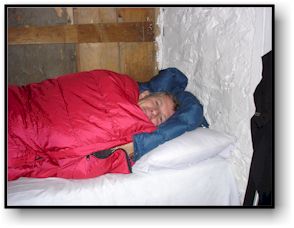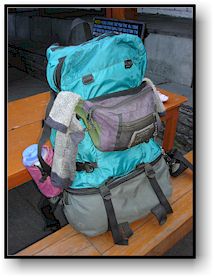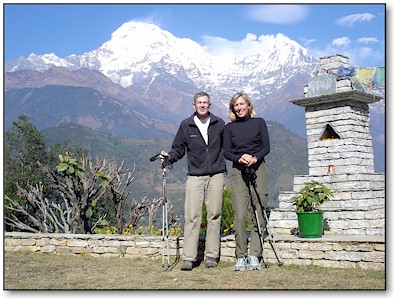Nepal Trekking - What to bring

Lightweight warm sleeping bag and down jacket (used as a pillow)

Lightweight backpack, fanny pack, water bottle
Bargains in Kathmandu: There are many camping equipment stores in Thamel area of Kathmandu. The items are bargain priced. You can rent or buy sleeping bags, down coats, waterproof pants, gloves etc for very little. Jack purchased a nice "North Face" (knock- off?) fleece jacket for $5 USD.
Important Items
One of our most valuable items on our trip was Hand Sanitizer. Make sure your sanitizer has at least 60% Ethyl Alcohol. We carried a 220 ml bottle and two very small bottles. Keep the big bottle in your pack and carry the smaller one in a day pack or in your pocket. Use a couple of drops on the palm of your hand before eating anything and after using every bathroom. Jack got sick (flu / cold) in Manang from eating popcorn from a big bowl with a bunch of other people. We came in contact with people with colds all along the way. Don't share food! Be aware of sick people (coughing) in the tea houses and stay away from them. Use your hand sanitizer.
Trekking Poles - We wouldn't go without them. When you are out of energy going uphill, you can push with your arms and reduce the amount of energy required by your legs. When going downhill, they greatly reduce the stress on your knees. Plus they give you four points of contact instead of two and much more stability. The trails are not even and the four points of contact help avoid injury (twisted ankles etc). Get a lightweight model that collapses. We have Leki Makalu Ultralight Titanium (no shock absorbers) and since we both have the same model, we put white tape on one set so they would not get mixed up. Learn how to use them here .
Toilet Paper is of very poor quality in Nepal. We suggest you bring some from your home country. One roll per person should be adequate. Learn to use as few "squares" as possible and use a handkerchief for blowing your nose (you can wash it out daily). TP is sold on the trail so you do not need to fill your pack with it. Of course, you can go "native" and use your left hand.
Here is what we took on our 26 day trek
Basics: Pack, the smaller and lighter the better. Also, a fanny pack or day pack. If you plan to have a porter carry your main load, get a reasonably sized day pack., one that will hold your jacket, camera and water Jack put a fanny pack on the outside of his main pack for access to often used items (see pic above). Sleeping Bag (we had lightweight down bags) you could survive without one as you can get blankets at the lodges but we recommend bringing your own. Sleeping bag liner (keeps it clean). Water bottle - one per person is sufficient. You should always use iodine tablets to sanitize your water. Get the two part tablet system with Iodine and vitamin C tablets which remove the iodine taste. We sanitized about 1.5 liters per day for two people (drank lots of tea daily). Money (see the money section here). LED headlamps (our one set of batteries lasted the whole trip). Guide Book (we took only one), map (we had the pocket map (Easy Map) "Trekking around Annapurna and the annapurna sanctuary" scale 1:160,000. You can find many maps in Kathmandu and Pokhara., Toilet Paper (see above)
Clothing: 4-5 pair underwear, 2 handkerchiefs, 2 T-shirts, 1 long sleeve T shirt, 1 pair long pants, belt (you will lose weight!), 4-5 pair hiking socks (the item most washed), lightweight socks (optional), 1 warm jacket (preferably down as it is lightweight and packs well), 1 pair fleece pants (wear in the evening or double up with regular pants). 1 mid-weight fleece jacket (used this a lot!). 1 pair thin lightweight gloves, 1 pair heavy gloves, 1 lightweight rain suit (pants and jacket, good on windy days too), 1 ball cap, 1 wool hat (or maybe a hood with your jacket); 1 pair long underwear, medium weight, 1 swim suit (we never used but you would at the hot springs), 1 pair shower shoes (open foot so you can wear with socks), 1 pair down booties or Ugg boots (optional but they are great after hiking), Hiking boots or sturdy trail shoes (the locals hike in trail shoes but whichever you choose, make sure they are broken in and comfortable at distance - we used lightweight hiking boots). 1 pair shorts (optional). Women should plan to wear slacks or a long skirt and not shorts on the trails.
Underwear, socks and handkerchiefs can be washed daily or every few days. They likely will not dry by the next morning so you might have to dry them on the outside of your pack while you hike during the day (see top right picture above, socks drying)
First Aid / Drugs: Hand sanitizer (see above); Small bottle (30 ml) of isopropyl alcohol, aspirin, sudafed, neosporin antibiotic cream, Band-Aids, gauze pads, 1 roll of cling bandage, thermometer, tweezers, small scissors, needle and thread, ibuprofen, One 4" wide elastic wrap (for wrapping sprained ankles etc), Cipro (two courses), Zithromax (1 course), Diamox (optional, for altitude), Benadryl, Immodium A-D, cough drops, cold medicine, iodine tablets (see above), moleskin or second skin for blisters
Toiletries: TP (see above), bar of soap, laundry bar (optional), shampoo, shaving gear (if so inclined), toothpaste, toothbrush, deodorant, and whatever else you might need for a few weeks.
Other items: Trekking poles, LED headlamps (see above), 1 large pack towel; 6 plastic clothes pins, trekking poles (see above), sunglasses, sunscreen, paper, notebook, pens, Nepali phrase book, business cards, digital camera, spare flash cards (we carried 3 Gb of memory and shot pics at 3 Megapixels. - Didn' t run out of memory but on the next trip we will take 5 Gb memory). Hook your camera to a belt or one of your pack straps for easy access; 1 set spare batteries and universal charger (runs off 110-240 volts) - You will likely be able to recharge batteries every 3 days or so depending on the village. Some times you will find an outlet in your room. You must have the European 220 volt two pin adapter. Make sure your charger can handle 220 volts. We also brought a very tiny, lightweight tripod, a calculator, altimeter (optional), compass (optional), matches/lighter, swiss army knife, duct tape (small amount), glue (for shoes, optional), power bars or candy bars (optional). Stuff sacks are good. Use a small one for your first aid gear, perhaps another for your socks and underwear etc. Also plastic bags and rubber bands are difficult to find. Bring some zip lock bags and rubberbands too.
We suggest you also read this associated page .
